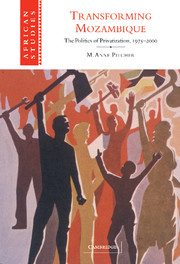Book contents
- Frontmatter
- Contents
- List of figures
- Preface
- List of abbreviations and acronyms
- Glossary
- Map
- Introduction
- 1 The reconfiguration of the interventionist state after independence
- 2 Demiurge ascending: high modernism and the making of Mozambique
- 3 State sector erosion and the turn to the market
- 4 A privatizing state or a statist privatization?
- 5 Continuities and discontinuities in manufacturing
- 6 Capital and countryside after structural adjustment
- 7 The end of Marx and the beginning of the market? Rhetorical efforts to legitimate transformative preservation
- Bibliography
- Index
- OTHER BOOKS IN THE SERIES
5 - Continuities and discontinuities in manufacturing
Published online by Cambridge University Press: 22 September 2009
- Frontmatter
- Contents
- List of figures
- Preface
- List of abbreviations and acronyms
- Glossary
- Map
- Introduction
- 1 The reconfiguration of the interventionist state after independence
- 2 Demiurge ascending: high modernism and the making of Mozambique
- 3 State sector erosion and the turn to the market
- 4 A privatizing state or a statist privatization?
- 5 Continuities and discontinuities in manufacturing
- 6 Capital and countryside after structural adjustment
- 7 The end of Marx and the beginning of the market? Rhetorical efforts to legitimate transformative preservation
- Bibliography
- Index
- OTHER BOOKS IN THE SERIES
Summary
Industry is the dynamising factor for economic development.
Third Frelimo Party Conference, 1977Industry must develop a dynamic, modernising role in the economy, stimulating its qualitative transformation and growth.
Ministry of Industry, Trade, and Tourism, 1997The sale of state enterprises in the manufacturing sector accounts for about half of all privatizations that have taken place in Mozambique. The government has sold breweries, bottling plants, textiles, plastics, and chemical factories. These companies produce mainly for the domestic market but have the potential to export abroad. While Mozambican nationals have purchased the majority of enterprises, foreign investment accounts for much of the value of total investment. It is concentrated in large factories such as brewing or bottling that dominate their respective sectors. In addition, many major new projects that are underway or that have been proposed contain significant foreign investment. As of 1999, approximately $6 billion has been pledged for these projects, and if the investment is fully realized, it will exceed the investment by those companies that have bought existing firms. The new projects include the creation of road and rail transport corridors linking ports in Mozambique with South Africa, Zimbabwe, and Malawi. The purpose of these corridors is to foster free trade zones and to encourage the growth of industry along the route. The government also is promoting iron and steel projects in Maputo and Beira, eco-friendly resorts, and the construction of petro-chemical plants.
- Type
- Chapter
- Information
- Transforming MozambiqueThe Politics of Privatization, 1975–2000, pp. 179 - 206Publisher: Cambridge University PressPrint publication year: 2002



